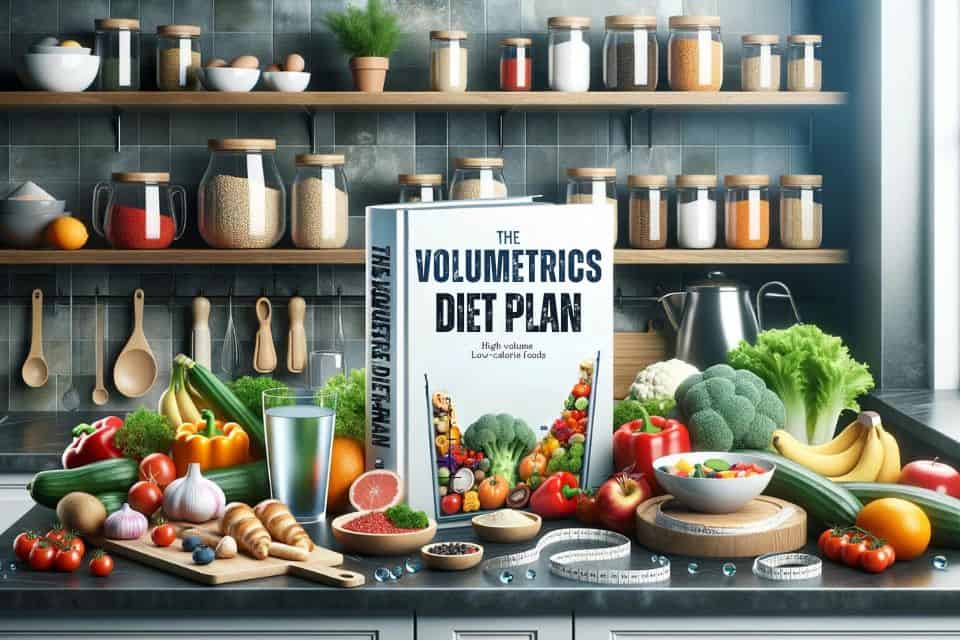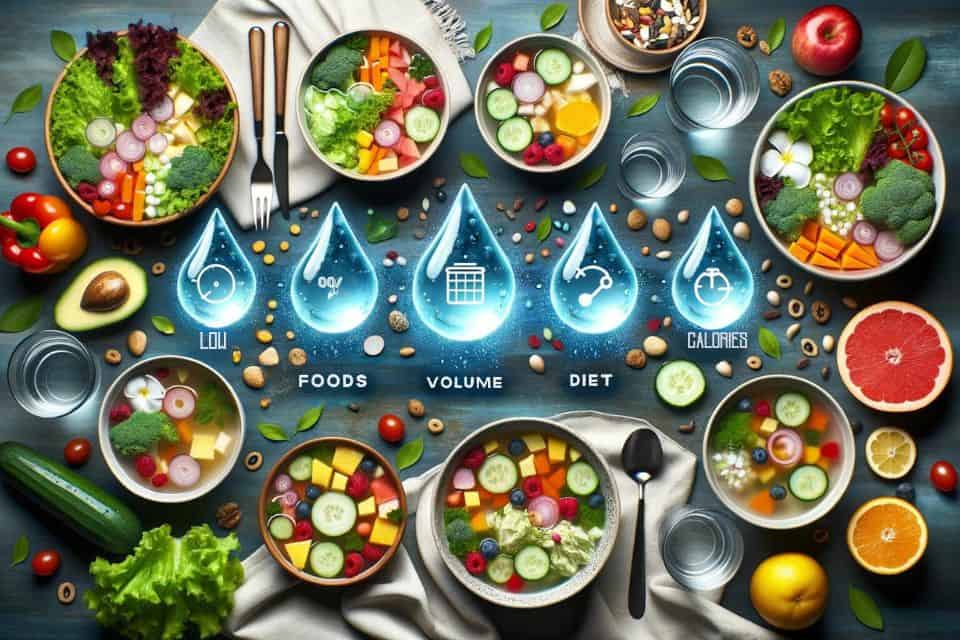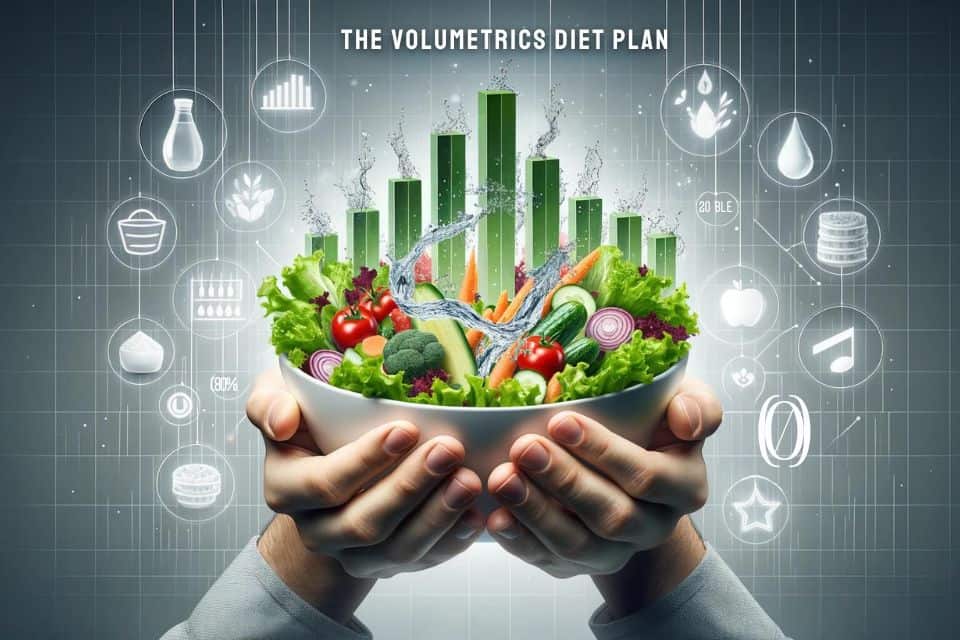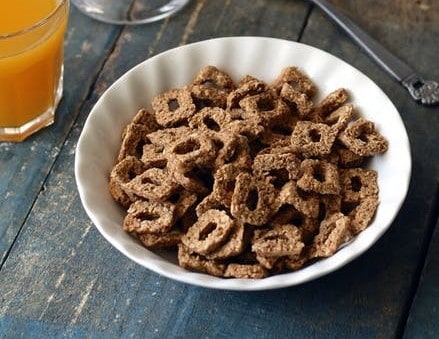Learn how to lose weight with the Volumetrics diet plan. Thanks to this program, you can still eat your favorite foods while losing weight quickly and safely.
The Volumetrics diet plan, created by renowned nutrition professor Rolls BJ, offers innovative, simple, science-based strategies for weight management. Unlike fad diets that focus on restrictive calorie counting and portion sizes, the Volumetrics approach prioritizes nutrient-dense foods and the volume of food you eat – hence the name.
Key Takeaways
- The Volumetrics diet plan emphasizes consuming low-calorie, high-volume foods to promote weight loss.
- By focusing on foods with low energy density, such as fruits, vegetables, and broth-based soups, you can feel fuller while consuming fewer calories.
- The diet encourages portion control and mindful eating to help you make healthier food choices.
- Including more water-rich foods in your diet, like soups and salads, can help increase satiety and reduce overall calorie intake.
- The Volumetrics diet plan promotes a balanced and sustainable approach to weight loss, making it a suitable option for long-term success.
Understanding Caloric Density vs Nutrient Density

Understanding the distinction between caloric and nutrient density is at the heart of this weight-loss diet. High-energy-density foods like white bread or fatty meats provide extensive calories in small amounts of food. In contrast, low-energy-density (or high-volume, low-calorie) foods like tomatoes and non-starchy vegetables such as green beans, broad beans, and black beans offer vast nutrients with fewer calories.
Quality over Quantity
The key to long-term weight loss with the Volumetrics diet is not just about reducing body mass or body fat but improving body composition by making healthier food choices. This flexible diet emphasizes food volume rather than drastically limiting caloric intake. It’s about consuming meals with fiber foods like brown rice and lentil soup instead of high-calorie and low-nutrient food items.
Meal Planning with Volumetrics

Meal planning in this diet involves attention to portion sizes but also aims at feelings of fullness using high-fiber and low-calorie foods or even low-carb, high-fiber foods like cooked quinoa. For instance, a nutritious meal might include a vegetable pilaf made from cups of vegetable broth with a cup of quinoa, cloves of garlic for flavoring, and cherry tomatoes for added freshness.
Cook time would be 18-20 minutes until the quinoa is tender but crunchy. Stir occasionally every 12-15 minutes to ensure even cooking. Drizzle with a tablespoon of olive oil1 onion mixture or tbsp olive oil for additional healthy fat content before serving hot soup.
Drinks are no exception; opt for zero-calorie drink options such as coconut or lemon water instead of sugary drinks to maintain your calorie goals without compromising your hydration needs.
Volumetrics counts on foods with a low-energy thickness and high water content, such as fruits and vegetables. By eating healthy foods, you can consume as much as you like and eliminate the sensations of hunger, fatigue, and clinical depression that often come with various other diet plans.
This low-calorie, high-volume consuming strategy includes foods with a great deal of water and fiber, given that both allegedly enhance your sense of fullness. It does not ban any food. Besides, you can enjoy calorie-packed foods if you stick to the suggested calorie intake.
Foods with reduced power density consist of:
– fruits.
– veggies.
– low-fat dairy products.
– whole grains.
– beans.
– lean meat.
Consume a lot of food – as much as you’re eating currently, or perhaps much more – and still drop extra pounds. It looks like an unlikely weight-loss strategy, right?
The Volumetrics diet plan was ranked number two for fat burning and tied for number five overall in the 2018 U.S. News & World Record’s Best Diet Rankings. It received positive ratings from nutrition experts for its safety, effectiveness, and long-term sustainability.
And also, yes, it focuses on one relatively simple idea: filling on fewer calories.
The main emphasis is consuming foods naturally low in calories and high in fiber or water, such as fruits, vegetables, and soups. Since carbohydrates and proteins provide 4 calories per gram, and fat provides nine calories per gram, you can consume more without exceeding your calorie limit. It is important to note that individuals following the Volumetrics diet can expect to lose up to 2 pounds per week.

Of course, like many points in life, there’s even more to the Volumetrics diet plan than satisfies the eye.
The Volumetrics Diet Menu
If diet plans with strict rules and constraints make you crazy, below’s your factor in coping: You don’t have to count calories, plan food, or log points on the diet plan. Volumetrics is not a specifically recommended diet plan but rather a fundamental nutritional method.
On the Volumetrics diet plan, food is divided into 4 groups, he discusses. Your goal: Eat primarily foods in teams one and two, be mindful of section sizes of foods in group 3, and lessen selections of foods from team 4. Don’t forget that absolutely nothing is completely off-limits.
1. Team one: non-starchy fruits and vegetables, non-fat milk, and broth-based soup.
2. Team two: starchy fruits and veggies, grains, morning meal grain, low-fat meat, legumes, low-fat mixed recipes like chili and spaghetti.
3. Team three: meat, cheese, pizza, french fries, salad dressing, bread, pretzels, ice cream, and cake.
4. Team 4: biscuits, chips, chocolate candies, cookies, nuts, butter as well as oil.
Below’s what you might consume on a typical day on the Volumetrics diet:
– Breakfast: Vegetable omelet with whole-wheat toast on the side.
– Early Morning Treat: Low-fat Greek yogurt with fruit.
– Lunch: Lean meat chili with beans and also veggies.
– Afternoon Treat: Air-popped snacks (no butter) with a glass of milk.
– Supper: A piece of fish, fit to be tied veggies, quinoa.
Does The Volumetrics Diet Plan Truly Work?
According to a solid scientific study (consisting of a 2016 meta-analysis of 13 pieces of research that discovered a connection between low-density foods and weight loss) and, well, excellent old-fashioned good sense, it works. The main reason that people break their healthy eating is that they feel hungry. You prevent those diet-busting hunger pains because you’re still consuming a high quantity of food on the Volumetrics plan.

Thousands of other nourishment studies back this up. In a 2007 study released in the American Journal of Scientific Nutrition, researchers arbitrarily assigned 97 overweight women to either a low-fat diet plan or a low-energy-one, low-fat diet plan that stressed fruits and vegetables. After a year, both groups reduced weight, yet the fruits-and-vegetables dieters lost much more – 14 pounds than 11 pounds. The scientists considered a low-energy-dense diet plan an efficient way to lose and keep pounds off.
A 2005 study published in obesity research shows that a diet plan with a high content of low-density foods and soup, a key element in the Volumetrics diet plan, is causing significant weight loss. Another research study of 186 ladies discovered lowering power density is a way to stop weight gain and excessive weight in both the short and long term.
The majority of low-calorie and high-volume foods are rich in nutrients. Consequently, positively affects your health and wellness in a variety of ways.
The Prospect Health Benefits of the Volumetrics Diet Plan.

Benefits Beyond Weight Loss
The benefits extend beyond mere weight loss maintenance too. Consuming various nutrient-rich foods can help manage health conditions like heart disease by reducing fat intake and risk of cardiovascular disease. Furthermore, meal preparation filled with fresh produce has been linked to lower energy intake overall and progressive weight reduction over time.
However, it’s essential to consult your healthcare provider if you have specific dietary requirements due to diseases such as celiac disease or Individuals with kidney problems, including Chronic Kidney Disease.
A sample 7-day volumetrics meal plan could include deliciously prepared healthy meals accentuated by an olive oil mixture consisting of tablespoons of olive oil salt that takes only an additional minute of prep time daily!
With less emphasis on restrictive diets and more emphasis on balanced diet quality, emphasizing nutrient density over caloric density — feeding yourself becomes less about restrictions and enjoyment—creating a way to lose body weight and a lifestyle conducive to good health.

The Prospect Disadvantages of the Volumetrics Diet Plan
Nevertheless, the Volumetrics diet is not without its drawbacks. The challenges of Volumetrics consist of the following:
– A Need to Prepare Volumetrics involves food preparation in your home, so this method might not help everyone. This diet plan is based on making your very own dishes. If you dine in a restaurant for business or satisfaction, this plan is not optimal.
– Just Short-Term Satiety Eating great deals of healthy foods under the Volumetrics plan will certainly help you feel complete, yet the impact may not last. When you consume high-water foods, you feel complete yet may feel hungry briefly. Try having healthy protein with your dishes to assist the feeling of satisfaction last much longer.
– No Strict Rules. This pro can easily be a con. Some dieters might discover convenience in guidelines and specific measurements that allow them to recognize that. If they insist on those measurements precisely, they’ll slim down. By comparison, the Volumetrics diet plan uses guidelines and ideas for satiety consumption. Yet, it doesn’t limit certain foods or give certain calorie limitations. The diet plan likewise encourages you to increase your exercise and remain energetic, but once again, it provides no specific guidelines. If you require those rules to keep you disciplined, this might not be your diet plan.
What are the Disadvantages?
If alarm bells displace your head, you’re not the only one. However, not all high-calorie foods are bad for you. Many foods high in calories and fat, such as seeds, nuts, avocados, and fatty fish, promote good health.

One potential downside to this diet plan is that it suggests a highly reduced intake of nuts and seeds (since they are high in calories). Nuts and seeds provide monounsaturated fats. Omega-3 provides fatty acids. Both are valuable for cardiovascular as well as cognitive wellness.
Like numerous diet plan plans, eating in restaurants on the Volumetrics diet can be challenging, considering that multiple restaurants and food services prepare their food with high-calorie, high-fat butter and oil. However, no foods are 100% restricted on this diet plan. It’s more about putting the principles into practice.
Should you Start?
You would like to discover some terrific soup dishes. Broth-based soups are low in energy density, and if you eat them before a dish, they can help you eat less.
Preparing your meals for the week ahead of time will be crucial to your success. Try to maintain some high-volume, suitable foods, such as fresh fruit and plenty of low-fat dairy. When you return from the grocery, prioritize food preparation to ensure no thinking during preparation time.
Finally, while it’s not vital, the diet plan strategy urges more daily activity. There’s no specific workout program, but it does recommend simply boosting the number of actions you take each day, reaching around 10,000 steps.
The bottom line? If prepping and eating low-energy foods and avoiding calories sounds manageable, you might be perfect for trying the Volumetrics diet plan.

How Easy Is It to Stick To the Volumetrics Diet Plan?
If you usually consume lots of refined food and do not enjoy fruits and veggies, embracing a Volumetrics diet plan might be challenging. Since the diet plan is high in water, it is reduced in calories, so this lower quantity may take some getting used to.
You might take pleasure in just how simplified the method is. It focuses on what you can consume rather than just taking things out of your diet. You’ll eat lots of healthy and balanced whole food, and also, it’s more of a lifestyle method. If you’re a person who likes rigorous rules or desires a fast fix, Volumetrics may be hard to follow.
The Volumetrics Diet Plan has been recognized and ranked highly by reputable sources for its effectiveness in promoting weight loss. Below are some of the accolades and recognitions the diet has received, showcasing its authoritative standing in the weight loss community:
- Ranked Among Top Diets:
- In 2022, the U.S. News and World Report ranked the Volumetrics Diet as the fifth-best overall, scoring 3.7 out of 5. Additionally, it was ranked the number-one diet for weight loss and the fifth-best diet for healthy eating.
- Similarly, in 2020, the Volumetrics Diet was tied for the second-best weight-loss diet by the U.S. News and World Report. It was also ranked fifth among 35 diets in the best weight loss category.
- Top Recognition for Weight Loss:
- The diet plan developed by Barbara Rolls at Penn State, dubbed Volumetrics, achieved the top rank among weight-loss diets for 2022 by U.S. News & World Report.
These rankings and recognitions from reputable sources reinforce the effectiveness of the Volumetrics Diet Plan in promoting weight loss and healthy eating. The consistently high rankings over the years highlight the diet’s potential as a reliable and effective approach for those seeking to lose weight and maintain a healthy lifestyle.
Tips for setting yourself up for success

Obtain comfy grocery buying. “Goal to keep great deals of fresh food, like vegetables and fruit, handy. Always having water-dense foods available will make you more likely to eat them.
Enjoy your food. Avoid considering consuming salads for each dish. Instead, get creative with healthy foods that suit the Volumetrics plan, like cauliflower rice, zucchini noodles, or carrot french fries.
Maintain an “in-a-pinch” dish strategy handy. Learning how to whip up two go-to meals when you’re short on time. In addition, doing some study on healthy and balanced takeout choices for when you do not feel like cooking would help. A little prep is a good way of helping you to stay on track.
FAQs
What is the Volumetrics Diet Plan?
Who created the Volumetrics Diet Plan?
How does the Volumetrics Diet Plan work?
Can you lose weight with the Volumetrics Diet Plan?
Conclusion
The Volumetrics Diet Plan is a game-changer for those seeking a sustainable and effective weight loss journey. Its focus on low-calorie density foods allows you to feel satisfied while shedding those extra pounds. No more restrictive diets or endless calorie counting!
Imagine enjoying a hearty bowl of soup or a plateful of fruits, all while reaching your weight loss goals. The Volumetrics Diet Plan offers a refreshing approach that doesn’t compromise on taste or enjoyment. It’s like having your cake and eating it too (well, maybe a smaller slice)!
But don’t just take my word for it. Countless successes have emerged from this innovative plan, and individuals have reclaimed their health and confidence. One user even shared how they found solace in satisfying soups during the chilly winter months; weight loss feels like a cozy adventure.
So why wait? Embrace the Volumetrics Diet Plan and embark on a journey towards a healthier, happier you! It’s time to ditch the dieting fluff and embrace a plan that truly works. Start your transformation today – one delicious bite at a time.
As a veteran fitness technology innovator and the founder of GearUpToFit.com, Alex Papaioannou stands at the intersection of health science and artificial intelligence. With over a decade of specialized experience in digital wellness solutions, he’s transforming how people approach their fitness journey through data-driven methodologies.
